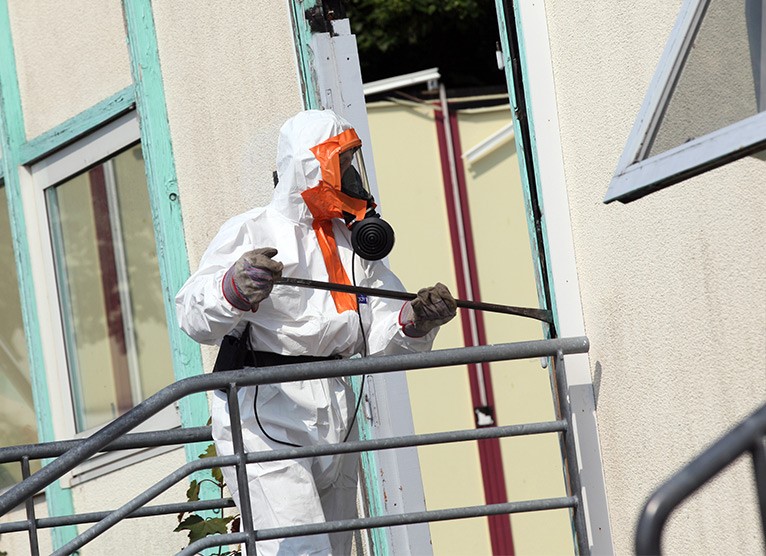Asbestos is a natural mineral that’s been used for centuries for all sorts of things, most recently as an additive in building materials and other manufactured products during the early to mid-20th century. While it was good for construction, researchers found that inhaling asbestos fibers could potentially lead to some life-threatening diseases, mainly in the lungs.
Although using asbestos has been banned in the UK since 1999, it can take 15-50 years for someone to show symptoms of an asbestos-related disease and there’s a lot of confusion around where it can be found, what it might look like and whether it can still pose a threat today. To help raise awareness and understanding, we’ve answered the most common questions below.

What is asbestos and why do I need to be aware of it?
Asbestos is a group of natural silicate minerals that have extraordinary properties such as chemical and thermal resistance. Because of this, it was widely used throughout the building trade and up to half of all homes in the UK are thought to contain asbestos. It’s difficult to identify because it’s usually embedded within building materials and other products.
Asbestos being present isn’t an immediate threat to your health, but the risk increases when the fibres are disturbed. The key to staying safe from exposure is to never break or demolish materials that could contain it. You should make sure you’ve taken the right precautions before you start a home improvement project as damaging older building products can break down asbestos fibres and release them into the air. Always consider common risk factors such as when your home was built or last renovated, if materials show obvious signs of deterioration, and if your home has been inspected by a professional recently.
What are the health risks associated with exposure?
The effects of exposure are often seen years after initial contact occurs and the most common diagnoses include asbestosis, lung cancer, and a terminal cancer called malignant mesothelioma. Secondhand exposure can occur if somebody comes into contact with an individual’s exposed clothing or belongings.
Although there’s no safe amount of exposure, homeowners are much less likely to develop an asbestos-related illness compared to tradespeople or other people who may work with the toxin on a regular basis. It’s important that tradespeople take proper safety precautions as more than 5,000 workers die from asbestos exposure each year.

Where can you find asbestos?
Due to its use within construction products, asbestos made its way into lots of homes, inspiring the British Lung Foundation to go one step further to educate the public about asbestos in old housing. They conducted a survey and found that out of 2,000 participants, only 22% were aware that asbestos use had been banned. Around 67% said they were unsure how to identify it indoors. With millions of homes built during the height of asbestos use, it’s important to educate people about where it can be found within housing and how you can protect yourself from breathing in the particles.
Some of the places that asbestos has been found include boiler pipes and ducts, flooring, ceiling coatings, cold water tanks, insulation, gutters, and under gutter roofs. It’s also been mixed into a variety of products, including old sealants, plaster, and spray coatings. Artex, a textured coating used for interior decorating, was often applied to the ceilings of older houses and has been known to be a risk.
What does it look like?
Asbestos is difficult to identify because it can be brown, blue, or white, and resides inside a long list of building products that can be inside walls, floors, or ceilings. Although it’s difficult to spot, the Health and Safety Executive has provided a gallery of images to give more of an idea of what it can look like.
What to do if you suspect asbestos
Just because asbestos is present it doesn’t mean you’ll automatically be exposed to it. For example, if your property contains an asbestos roof with no signs of leaks or damage, there’s no need to remove it because the fibres are undisturbed. If you spot corroded or worn out building materials, the best thing to do is to avoid coming into contact with it until a professional can take a look at it. It poses little threat to our lungs if it’s successfully kept intact, but it’s important to make sure asbestos-containing materials don’t show visible signs of age or deterioration.
Embarking on a home improvement project can become a source of exposure because many tasks like tearing down cabinets, replacing old floors, scraping paint, or refurbishing the basement involve damaging old materials in some shape or form. When it comes to doing up a home, it’s always worth researching and investing in reliable personal protective equipment (PPE) such as a half face or full mask respirator. If you choose to hire a tradesperson, let them know about any concerns so they can take appropriate action.





This is a great, well written and informative article. It’s so important that people are asbestos aware and know the risks involved. We are experienced Asbestos surveyors working all over the UK and we also deliver Asbestos training courses UK wide. If anyone needs any help at all with an asbestos survey or training, please visit our website armco.org.uk